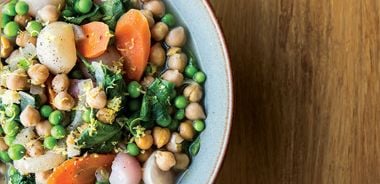Lemony Early Spring Vegetable and Chickpea Stew

Forget the heavy, stick-to-your-ribs stews of winter: this zesty and bright creation will leave you feeling light and revitalized. Whenever possible, use organic ingredients. If you have leftover cooked brown rice, quinoa, or pasta, stir that in along with the chickpeas.
2 Tbsp (30 mL) extra-virgin olive oil 1 onion, halved and cut into thin rounds 2 medium carrots, cut on the diagonal into thin slices 2 cups (500 mL) halved radishes 2 cups (500 mL) cooked chickpeas 1 cup (250 mL) vegetable broth 1/2 tsp (2 mL) sea salt 1/4 tsp (1 mL) ground pepper 2 cups (500 mL) fresh spinach 1 cup (250 mL) fresh or frozen peas Zest of 1 lemon 2 Tbsp (30 mL) lemon juice
In large pot or Dutch oven, heat oil over medium heat. Add onion, carrots, and radishes. Sauté for 10 minutes, or until vegetables become slightly tender. Add chickpeas, broth, salt, and pepper. Bring to a boil, reduce to a simmer, cover, and cook for 20 minutes, or until vegetables are very tender.
Immediately before serving, stir in spinach, peas, lemon zest, and lemon juice. Once spinach is bright green and wilted, about 1 minute, serve.
Serves 4.
Each serving contains: 274 calories; 12 g protein; 10 g total fat (1 g sat. fat, 0 g trans fat); 36 g total carbohydrates (10 g sugars, 8 g fibre); 442 mg sodium
source: "Early Spring Produce", alive #389, March 2015





